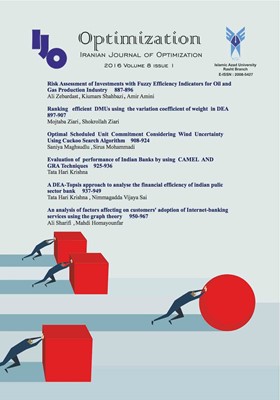رتبه بندی DMU ها کارآمد با استفاده از ضریب تغییرات وزن در DEA
Subject Areas : Data Envelopment Analysis
Mojtaba Ziari
1
,
Shokrollah Ziari
2
![]()
1 - Member of young researchers and elite club, Firoozkooh branch, Islamic Azad University, Firoozkooh, Iran
2 - Department of Mathematics, Firoozkooh branch, Islamic Azad University, Firoozkooh, Iran
Keywords:
Abstract :
یکی از مشکلات آنالیز پوششی داده ها (DEA) مشکل تبعیض در میان واحدهای تصمیم گیری کارآمد (DMUs) است و بنابراین، منجر به تعداد زیادی DMU به عنوان کار آمد میشود. هدف اصلی این مقاله غلبه بر این ناتوانی است. یکی از روش ها برای رتبه بندیی DMU های کارآمد به حداقل رساندن ضریب تغییرات (CV) برای ورودی-خروجی وزن میباشد. در این مقاله، یک مدا غیر خطی برای رتبه بندی DMU کارآمد مبتنی بر به حداقل رساندن انحراف مطلق میانگین وزن ها معرفی کردیم و سپس ما مدل غیر خطی به یک فرم برنامخ ریزی خطی تبدیل کردیم.
Adler, N., Friedman, L., & Sinuany-Stern, Z. (2002). Review of ranking methods in the data envelopment analysis context. European Journal of Operational Research, 140, 249-265.
Amirteimoori, A., Jahanshahloo, G.R., & Kordrostami ,S. (2005). Ranking of decision making units in data envelopment analysis: A distance-based approach, Applied Mathematics and Computation, 171,122-135.
Andersen, P., & Petersen, N.C. (1993). A procedure for ranking efficient units in data envelopment analysis. Manage. Sci, 39, 1261-1264.
Bal, H., orkcu, H. H., & Celebioglu, S. (2008). A new method based on the dispersion of weights in data envelopment analysis. Journal of Computers Industrial Engineering, 54, 502-512.
Banker, R.D.,Charnes, A., & Cooper, W.W. (1984). Some methods for estimating technical and scale inefficienciesin data envelopment analysis. Manage. Sci, 30 (9), 1078-1092.
Charnes, A., Cooper, W.W., & Rhodes, E. (1978). Measuring the efficiency of decision making units. Eur.J. Oper.Res,2 (6), 429-444.
Cooper, W. W.,Seiford, L. M., & Tone, K.(2007). Data Envelopment Analysis: A Comprehensive Text with Models, Applications, References and DEA-solver Software, Second Edition, Spriger.
Hashimato, A.(1999). A ranked voting system using a DEA/AR exclusion model:A note, Eur. J. Oper.Res,97, 600-604.
Jahanshahloo, G.R.,Hosseinzadeh Lotfi, F., Shoja, N., & Tohidi, G., Razavian, S.(2004). Ranking by using L1-norm in data envelopment analysis. Appl. Math.Comput. 153, 215-224.
Jahanshahloo, G.R. , Sanei, M., Hosseinzadeh Lotfi, F., & Shoja, N. (2004). Using the gradient line for ranking DMUs in DEA. Applied Mathematics and Computation, 151, 209-219.
Jahanshahloo, G.R. , & Firoozi Shahmirzadi, P.(2013). New methods for ranking decision making units based on the dispersion of weights and Norm 1 in data envelopment analysis. Computers & Industrial Engineering, 65, 187-193.
Khodabakhshi, M., & Aryavash, K.(2012). Ranking all units in data envelopment analysis. Applied Math-ematics Letters, 25, 2066-2070.
Liu, F. F., & Peng, H. H.(2008). Ranking of units on the DEA frontier with common weights. Computers & Operations Research, 35, 1624-1637.
Mehrabian, S., Alirezaee, M.R., & Jahanshahloo, G.R.(1999). A compelete efficiency ranking of decision making units in data envelopment analysis. Comput.Optimiz. Appl,14, 261-266.
Rezai Balf, F.,Zhiani Rezai, H., Jahanshahloo, G.R., & Hosseinzadeh Lotfi, F.(2012). Ranking efficient DMUs using the Tchebycheff norm. Applied Mathematical Modelling ,36, 46-56.
Seiford, L. M., & Zhu, J.(1999). Infeasibility of super-efficiency data envelopment analysis models. INFOR ,37 (2), 174-187.
Sexton, T. R. (1986).The methodology of data envelopment analysis. In R. H.Silkman (Ed.), Measuring efficiency: An assessment of data envelopment analysis, San Fransisco, Jossey-Bass, 7-29.
Shetty, U. , & Pakkala, T. P. M.(2010). Ranking efficient DMUs based on single virtual DMU in DEA.Operational Research Society, 47(1), 20-72.
Torgesen, A. M., Forsund, F. R., & Kittelsen, S.A.C.(1996). Slack-adjusted efficiency measures and ranking of efficient units, The J. Prod.Anal, 7, 379-398.
Wua, J., & Yan, H.(2010). An effective transformation in ranking using l1-norm in data envelopment analysis. Applied Mathematics and Computation ,217, 4061-4064.


